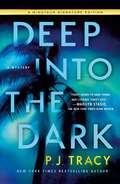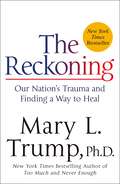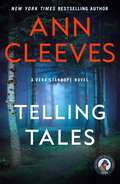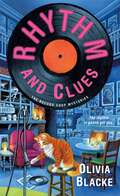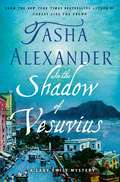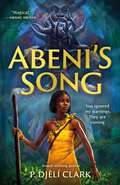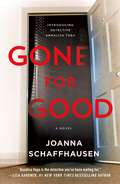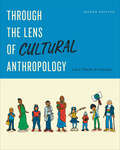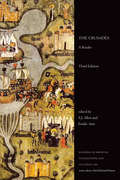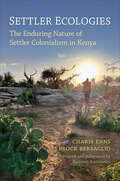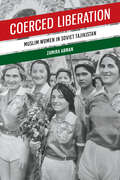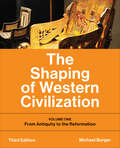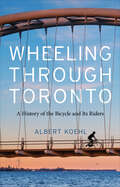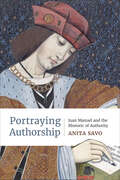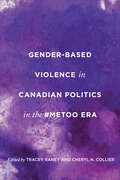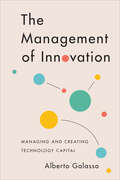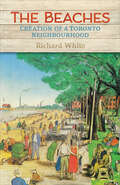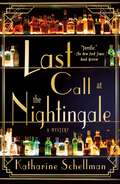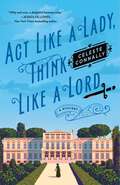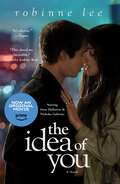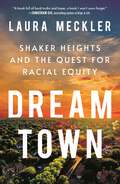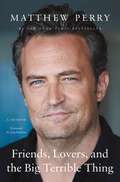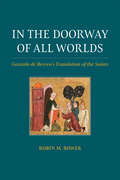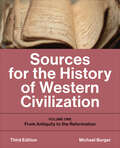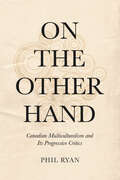- Table View
- List View
Deep into the Dark: A Mystery (The Detective Margaret Nolan Series #1)
by P. J. Tracy“Tracy seems to have found her literary sweet spot.” —Marilyn Stasio, The New York Times Book Review New York Times bestseller P. J. Tracy returns with Deep into the Dark, a brand new series set in LA and featuring up-and-coming LAPD Detective Margaret Nolan and murder suspect Sam Easton.Sam Easton—a true survivor—is home from Afghanistan, trying to rebuild a life in his hometown of LA. Separated from his wife, bartending and therapy sessions are what occupy his days and nights. When friend and colleague Melody Traeger is beaten by her boyfriend, she turns to Sam for help. When the boyfriend turns up dead the next day, a hard case like Sam is the perfect suspect.But LAPD Detective Margaret Nolan, whose brother recently died serving overseas, is sympathetic to Sam's troubles, and can't quite see him as a killer. She's more interested in the secrets Melody might be keeping and the developments in another murder case on the other side of town.Set in an LA where real people live and work--not the superficial LA of Beverly Hills or the gritty underbelly of the city--Deep into the Dark features two really engaging, dynamic main characters and explores the nature of obsession, revenge, and grief.P. J. Tracy is known for her "fast, fresh, and funny" characters (Harlan Coben) and her "sizzling" plots (People); the Monkeewrench series was her first, set in Minneapolis and co-written with her mother. Now with Deep into the Dark she's on her own—and it's a home run.
The Reckoning: Our Nation's Trauma and Finding a Way to Heal
by Mary L. Trump PhDThe instant New York Times and USA Today bestseller America is suffering from PTSD—The Reckoning diagnoses its core causes and helps us begin the healing process.For four years, Donald J. Trump inflicted an onslaught of overlapping and interconnected traumas upon the American people, targeting anyone he perceived as being an “other” or an enemy. Women were discounted and derided, the sick were dismissed as weak and unworthy of help, immigrants and minorities were demonized and discriminated against, and money was elevated above all else. In short, he transformed our country into a macro version of his malignantly dysfunctional family.How can we make sense of the degree to which our institutions and leaders have let us down? How can we negotiate a world in which all sense of safety and justice seems to have been destroyed? How can we—as individuals and as a nation—confront, process, and overcome this loss of trust and the ways we have been forever altered by chaos, division, and cruelty? And when the dust finally settles, how can we begin to heal, in the midst of ongoing health and economic crises and the greatest political divide since the Civil War?Mary L. Trump is uniquely positioned to answer these difficult questions. She holds a Ph.D. in clinical psychology specializing in trauma, has herself been diagnosed with post-traumatic stress disorder, and happens to be Donald J. Trump’s only niece. In The Reckoning, she applies her unique expertise to the task of helping us confront an all-encompassing trauma, one that has taken an immense toll on our nation’s health and well-being.A new leader alone cannot fix us. Donald J. Trump is only the latest symptom of a disease that has existed within the body politic since America’s inception—from the original sin of slavery through our unceasing, organized commitment to inequality. Our failure to acknowledge this, let alone root it out, has allowed it to metastasize. Now, we are confronted with the limits of our own agency on a daily basis. Whether it manifests itself in rising levels of rage and hatred, or hopelessness and apathy, the unspeakable stress of living in a country we no longer recognize has affected all of us for a long time, in ways we may not fully understand. An enormous amount of healing must be done to rebuild our lives, our faith in leadership, and our hope for this nation. It starts with The Reckoning.
Telling Tales: A Vera Stanhope Mystery (Vera Stanhope #2)
by Ann CleevesFrom Ann Cleeves—New York Times bestselling and award-winning author of the Vera and Shetland series, both of which are hit TV shows—comes Telling Tales. “Ann Cleeves is one of my favorite mystery writers.”—Louise Penny It has been ten years since Jeanie Long was charged with the murder of fifteen-year-old Abigail Mantel. Now residents of the East Yorkshire village of Elvet are disturbed to hear of new evidence proving Jeanie’s innocence. Abigail’s killer is still at large.For one young woman, Emma Bennett, the revelation brings back haunting memories of her vibrant best friend--and of that fearful winter’s day when she had discovered her body lying cold in a ditch.As Inspector Vera Stanhope makes fresh enquiries on the peninsula and villagers are hauled back to a time they hoped to forget, tensions begin to mount. But are people afraid of the killer or of their own guilty pasts?With each person’s story revisited, the Inspector begins to suspect that some deadly secrets are threatening to unfurl…
Rhythm and Clues: The Record Shop Mysteries (The Record Shop Mysteries #3)
by Olivia BlackeThe rhythm is gonna get you.It’s been five whole months since the last murder in Cedar River, Texas, and Juni Jessup and her sisters Tansy and Maggie have been humming along when disaster strikes again.Their struggling vinyl records shop/coffee nook, Sip & Spin Records, is under pressure from predatory investors, though the Jessup sisters aren’t ready to face the music and admit defeat. But the night after their meeting, the sketchy financier is killed outside their shop during a torrential Texas thunderstorm that washes out all the roads in and out of town. Now the sisters find themselves trapped in Cedar River with a killer, and Juni is determined to solve the case.When the river spits out an unexpected surprise, Detective Beau Russell asks for Juni’s help, never predicting her investigation will spin her into danger. Up until now, the Jessup sisters have been playing it by ear, but with the whole town watching, can they catch a killer before he strikes again?
In the Shadow of Vesuvius: A Lady Emily Mystery (Lady Emily Mysteries #14)
by Tasha AlexanderIn skillfully intertwined storylines from the dawn of the twentieth century and the heyday of the Roman Empire, Tasha Alexander's In the Shadow of Vesuvius, the latest installment to her bestselling series, brings Lady Emily and her husband to Pompeii, where they uncover a recent crime in the ancient city. Some corpses lie undisturbed longer than others. But when Lady Emily discovers a body hidden in plain sight amongst the ruins of Pompeii, she sets in motion a deadly chain of events that ties her future to the fate of a woman whose story had been lost for nearly two thousand years. Emily and her husband, Colin Hargreaves, have accompanied her dear friend Ivy Brandon on a trip to Pompeii. When they uncover a corpse and the police dismiss the murder as the work of local gangsters, Emily launches an investigation of her own. She seems to be aided by the archaeologists excavating the ruins, including a moody painter, the enigmatic site director, and a free-thinking American capable of sparring with even the Duke of Bainbridge. But each of them has secrets hiding among the ruins. The sudden appearance of a beautiful young woman who claims a shocking relationship to the Hargreaves family throws Emily’s investigation off-course. And as she struggles to face an unsettling truth about Colin’s past, it becomes clear that someone else wants her off the case—for good. Emily’s resolve to unearth the facts is unshakable. But how far below the surface can she dig before she risks burying herself along with the truth?
Abeni's Song (Abeni's Song #1)
by P. Djèlí ClarkIN DARKNESS, A SONG CAN LEAD THE WAY. BEWARE WHICH ONE YOU LISTEN TO. Abeni's Song by award-winning author P. Djèlí Clark is the enchanting beginning of an epic West African and African Diaspora-inspired fantasy adventure for middle-grade readers about a reluctant apprentice to magic and the stolen villagers she sets out to save.“Lush and magical.” —KWAME MBALIA • “Astonishing.” —MARK OSHIRO • "Abeni's story will sweep you away." —AMANDA FOODY On the day of the Harvest Festival, the old woman who lives in the forest appears in Abeni's village with a terrible message: You ignored my warnings. It’s too late to run. They are coming.Warriors with burning blades storm the village. A man with a cursed flute plays an impossibly alluring song. And everyone Abeni has ever known and loved is captured and marched toward far-off ghost ships set for even more distant lands.But not Abeni. Abeni is magically whisked away by the old woman. In the forest, Abeni begins her unwanted magical apprenticeship, her journey to escape the witch, and her impossible mission to bring her people home.Abeni’s Song is the beginning of a timeless, enchanting fantasy adventure about a reluctant apprentice, a team of spirit kids, and the village they set out to save.At the Publisher's request, this title is being sold without Digital Rights Management Software (DRM) applied.
Gone for Good: A Novel (Detective Annalisa Vega #1)
by Joanna SchaffhausenGone For Good is the first in a new mystery series from award-winning author Joanna Schaffhausen, featuring Detective Annalisa Vega, in which a cold case heats up.The Lovelorn Killer murdered seven women, ritually binding them and leaving them for dead before penning them gruesome love letters in the local papers. Then he disappeared, and after twenty years with no trace of him, many believe that he’s gone for good.Not Grace Harper. A grocery store manager by day, at night Grace uses her snooping skills as part of an amateur sleuth group. She believes the Lovelorn Killer is still living in the same neighborhoods that he hunted in, and if she can figure out how he selected his victims, she will have the key to his identity.Detective Annalisa Vega lost someone she loved to the killer. Now she’s at a murder scene with the worst kind of déjà vu: Grace Harper lies bound and dead on the floor, surrounded by clues to the biggest murder case that Chicago homicide never solved. Annalisa has the chance to make it right and to heal her family, but first, she has to figure out what Grace knew—how to see a killer who may be standing right in front of you. This means tracing his steps back to her childhood, peering into dark corners she hadn’t acknowledged before, and learning that despite everything the killer took, she has still so much more to lose.
Through the Lens of Cultural Anthropology: Second Edition
by Laura Tubelle GonzálezThrough the Lens of Cultural Anthropology presents an introduction to cultural anthropology designed to engage students who are learning about the anthropological perspective for the first time. The book offers a sustained focus on language, food, and sustainability in an inclusive format that is sensitive to issues of gender, sexuality, race, and ethnicity. Integrating personal stories from her own fieldwork, Laura Tubelle de González brings her passion for transformative learning to students in a way that is both timely and thought-provoking. The second edition has been revised and updated throughout to reflect recent developments in the field. It includes further discussion of globalization, an expanded focus on Indigenous peoples in the United States and Canada, revised discussion of sexuality and gender identities across the globe, a brief introduction to the anthropology of science, and updated box features and additional discussion questions that focus on applying concepts. Beautifully illustrated with over sixty full-color images, including comics and maps, Through the Lens of Cultural Anthropology brings concepts to life in a way that resonates with student readers. The second edition is supplemented by a full suite of updated instructor and student resources. For more information, go to lensofculturalanthropology.com.
The Crusades: A Reader, Third Edition (Readings in Medieval Civilizations and Cultures #VIII)
by S. J. Allen Emilie AmtSince its first appearance in 2004, The Crusades: A Reader has been the go-to sourcebook in the field. S.J. Allen and Emilie Amt cover the entire crusading movement, from its origins to its modern afterlife, using key primary source documents. The third edition features a new introduction that includes a guide for students on how to use the book. The editors have also added more content on women, material culture, Jewish and Byzantine perspectives, Muslim-Crusader interactions, and modern use of Crusade imagery and rhetoric by the Far Right. The geographic range is broad, covering not only Crusades in the Middle East, but also in Spain and in northern Europe and against European heretics. While scholarship, courses, and textbooks on the Crusades have proliferated over the past twenty years, The Crusades: A Reader remains the only comprehensive, up-to-date, and in-print sourcebook available on the subject.
Settler Ecologies: The Enduring Nature of Settler Colonialism in Kenya
by Charis Enns Brock BersaglioSettler Ecologies tells the story of how settler colonialism becomes memorialized and lives on through ecological relations. Drawing on eight years of research in Laikipia, Kenya, Charis Enns and Brock Bersaglio use immersive methods to reveal how animals and plants can be enrolled in the reproduction of settler colonialism. The book details how ecological relations have been unmade and remade to enable settler colonialism to endure as a structure in this part of Kenya. It describes five modes of violent ecological transformation used to prolong structures of settler colonialism: eliminating undesired wild species; rewilding landscapes with more desirable species to settler ecologists; selectively repeopling wilderness to create seemingly more inclusive wild spaces and capitalize on biocultural diversity; rescuing injured animals and species at risk of extinction to shore up moral support for settler ecologies; and extending settler ecologies through landscape approaches to conservation that scale wild spaces. Settler Ecologies serves as a cautionary tale for future conservation agendas in all settler colonies. While urgent action is needed to halt global biodiversity loss, this book underscores the need to continually question whether the types of nature being preserved advance settler colonial structures or create conditions in which ecologies can otherwise be (re)made and flourish.
Coerced Liberation: Muslim Women in Soviet Tajikistan
by Zamira AbmanIn 1924, the Bolshevik regime began an unprecedented campaign to forcibly emancipate the Muslim women of Tajikistan. The emancipatory reforms included unveiling women, passing progressive family code laws, and educating women. By the 1950s, the Soviet regime largely succeeded in putting an end to veiling, child marriage, polygamy, and bride payments. Yet today there is a resurgence in these practices the Bolsheviks claimed to have eliminated. Coerced Liberation reveals that the Soviet regime transformed the lives of urban women within a single generation but without lasting effect. Drawing on unique primary sources, the book examines why this occurred. It addresses questions that are pertinent to ongoing debates in the international arena: What happens when an outside force attempts to modernize a society deeply rooted in centuries of patriarchal norms and values? In what ways can a devout religious rural community respond to, survive, and adapt to such interventions? And how does a state-centred, top-down approach towards women’s emancipation work? Coerced Liberation presents critical insights for readers interested in gender dynamics within Muslim communities, the roles of women in Islam, the resurgence of Islam in former colonial territories, the effectiveness of a top-down approach towards women’s movements, and more.
The Shaping of Western Civilization: Volume One: From Antiquity to the Reformation, Third Edition
by Michael BurgerIn this overview, Michael Burger’s pedagogical goal is to provide a brief historical narrative of Western civilization to enable students to engage more fully with primary sources. The no-frills, uncluttered format and well-written, one-author approach make this book an affordable yet valuable asset for every history student. The third edition features stylistic and substantive revisions throughout. Volume One includes additional coverage of the neolithic revolution, the evolving self-definition of the West, race in the Middle Ages, the Crusades, and the conquest of the Americas, as well as new and improved maps.
Wheeling through Toronto: A History of the Bicycle and Its Riders
by Albert KoehlHighlighting an important yet often ignored part of Toronto’s transportation story, Wheeling through Toronto chronicles the history of the bicycle and reveals a way forward for a world in climate crisis. Throughout its history in Toronto, the bicycle’s place on the roads and in public esteem has fluctuated wildly: flaunted as fashionable, disparaged and derided, rescued from looming obscurity, and promoted as a way to respond to the challenges of the day. What is it about the simple bicycle that it can be so loved by some yet despised and detested by others? Wheeling through Toronto offers a 130-year ride from the 1890s to the present to help answer this question. Albert Koehl, a Toronto lawyer and leading cycling advocate, chronicles the tumultuous history of this mode of transportation from the bicycle craze at the turn of the century, to the rise of the car and the motorway in the 1950s, to the intensifying cry for active transportation in the 1990s and into pandemic times. In an era of catastrophic climate events, Wheeling through Toronto highlights how the bicycle should be celebrated not only as hope for the future, but also for its affordability, for its contribution to clean and healthy mobility, and because it brings happiness and joy to so many. Drawing on archival materials, newspapers, and personal interviews, and full of fascinating vignettes, this book presents the story of how we got here and what Torontonians need to know as we pedal forward.
Portraying Authorship: Juan Manuel and the Rhetoric of Authority (Toronto Iberic #88)
by Anita SavoPortraying Authorship argues that the medieval Castilian writer Juan Manuel fashioned a seemingly modern authorial persona from the accumulation and synthesis of medieval authorial roles. In the manuscript culture of medieval Castile and across Latin Europe, writers typically referred to their work in ways that corresponded to their role in the bookmaking process: scribes took credit for preserving the works of others, compilers for combining disparate texts in productive ways, commentators for explaining obscure works, and authors for writing their own words. Combining literary analysis with book history, Anita Savo reveals how Juan Manuel forged his authorial persona, “Don Juan,” by adopting all four medieval writerly roles, thereby reaping the ethical benefits of each one. Each chapter in Portraying Authorship highlights a different authorial role to show how Don Juan – and others who wrote in his name – assumed responsibility for that role and adapted its rhetoric to his vernacular literary project. The book concludes that Don Juan’s authorial self-portrait not only gave the humanist writers of the fifteenth century a model to imitate, but also persuaded subsequent scribes, editors, and translators to portray him as an individual author. In doing so, Portraying Authorship illuminates how Juan Manuel’s concept of authorship helped to secure him a privileged position in narratives of Spanish literary history.
Gender-Based Violence in Canadian Politics in the #MeToo Era
by Tracey Raney Cheryl N. CollierGender-based violence in politics is a significant and growing problem that threatens the democratic process in Canada. Despite its prevalence, little academic research has been conducted on this topic to date. Gender-Based Violence in Canadian Politics in the #MeToo Era raises awareness of and presents new innovative research on this timely and pressing public issue. Here, leading experts from across Canada uncover critical new insights and identify potential solutions that would help address gender-based violence in politics, improve gender equality, and strengthen Canadian democracy. Using an intersectional lens, chapters range in their approaches; offer new concepts and measures of gender-based violence in online political spaces, political media coverage and cartoons, campaigns, municipal politics, and legislatures; and explore Indigenous ways of knowing about gender-based violence in Canadian politics. Additionally, the volume presents recommendations for decision-makers, policymakers, anti-violence advocates, and the academic community on how to best address the problem of gender-based violence in the political sphere.
The Management of Innovation: Managing and Creating Technology Capital
by Alberto GalassoDespite the importance of innovation for the growth of firms, industries, and the national economy, the strategic tools available to effectively manage and create new technologies are often neglected by entrepreneurs and corporate managers. The Management of Innovation examines how firms can leverage and create technology capital. Over the past two decades, economists and management scholars have developed several new insights into how large companies and startups can be more innovative. Many of these research findings have not yet reached management practice. Alberto Galasso aims to address this issue by providing an accessible overview of the innovation literature and a discussion of the latest research findings. The analysis considers the two key stages of the innovation process: technology management and technology creation. Each stage involves complex managerial decisions related to resource allocation and the assessment of relevant costs and benefits. This book examines the most frequent trade-offs that shape the innovation process across these two stages. It also provides an introduction to intellectual property and patent analytics. The Management of Innovation provides MBA students and practitioners with tools and insights to innovate successfully.
The Beaches: Creation of a Toronto Neighbourhood
by Richard WhiteThe Beaches is one of Toronto’s best known and most admired neighbourhoods. It has no striking works of architecture or splendid public spaces, no must-see galleries or public institutions, and no associations with historic events or great celebrities – the sort of things that create neighbourhood reputations and draw visitors. It does, however, have an attractive character, and it is this character that Richard White seeks to understand, offering insights into how it came to be and why it has endured. With an eye to the broader historical context, The Beaches recounts the neighbourhood’s initial colonial settlement, its development as a lakeside recreational community in the late nineteenth century, its emergence as a streetcar suburb after 1900, its maturation in the 1920s and 1930s, its relative decline in the 1950s and 1960s, and its revival in the 1970s and beyond. Utilizing a wide range of archival records, including council minutes, plans of subdivision, newspapers, public land records, city directories, assessment rolls, and historical photographs – as well as the present-day landscape – The Beaches reveals the various forces, public and private, local and international, that shaped this cherished urban neighbourhood.
Last Call at the Nightingale: A Mystery (The Nightingale Mysteries #1)
by Katharine SchellmanFirst in a captivating Jazz age mystery series from author Katharine Schellman, Last Call at the Nightingale beckons readers into a darkly glamorous speakeasy where music, liquor, and secrets flow."Schellman is at the top of her craft and delivers a murder mystery with clever twists and turns and memorable personalities."—Denny S. Bryce, Bestselling Author of Wild Women and the BluesNew York, 1924. Vivian Kelly's days are filled with drudgery, from the tenement lodging she shares with her sister to the dress shop where she sews for hours every day.But at night, she escapes to The Nightingale, an underground dance hall where illegal liquor flows and the band plays the Charleston with reckless excitement. With a bartender willing to slip her a free glass of champagne and friends who know the owner, Vivian can lose herself in the music. No one asks where she came from or how much money she has. No one bats an eye if she flirts with men or women as long as she can keep up on the dance floor. At The Nightingale, Vivian forgets the dangers of Prohibition-era New York and finds a place that feels like home.But then she discovers a body behind the club, and those dangers come knocking.Caught in a police raid at the Nightingale, Vivian discovers that the dead man wasn't the nameless bootlegger he first appeared. With too many people assuming she knows more about the crime than she does, Vivian finds herself caught between the dangers of the New York's underground and the world of the city's wealthy and careless, where money can hide any sin and the lives of the poor are considered disposable...including Vivian's own.
Act Like a Lady, Think Like a Lord: A Mystery (Lady Petra Inquires #1)
by Celeste ConnallyBridgerton meets Agatha Christie in Act Like a Lady, Think Like a Lord, a dazzling first entry in a captivating new Regency-era mystery series with a feminist spin from Celeste Connally.London, 1815. Lady Petra Forsyth, daughter of the Earl of Holbrook, has made a shocking proclamation. After losing her beloved fiancé in an accident three years earlier, she announces in front of London’s loosest lips that she will never marry. A woman of independent means—and rather independent ways—Petra sees no reason to cede her wealth and freedom to any man now that the love of her life is gone. Instead, she plans to continue enjoying the best of society without any expectations.But when ballroom gossip suggests that a longtime friend has died of a fit due to her “melancholia” while in the care of a questionable physician, Petra vows to use her status to dig deeper. Just as Petra has reason to believe her friend is alive, a shocking murder proves more danger is afoot than she thought. And the more determined Lady Petra becomes in uncovering the truth, the more her own headstrong actions and desire for independence are used against her, putting her own freedom—and possibly her life—in jeopardy.
The Idea of You: A Novel
by Robinne LeeNow an original movie on Prime Video starring Anne Hathaway and Nicholas Galitzine! When Solène Marchand, the thirty-nine-year-old owner of a prestigious art gallery in Los Angeles, takes her daughter, Isabelle, to meet her favorite boy band, she does so reluctantly and at her ex-husband’s request. The last thing she expects is to make a connection with one of the members of the world-famous August Moon. But Hayes Campbell is clever, winning, confident, and posh, and the attraction is immediate. That he is all of twenty years old further complicates things.What begins as a series of clandestine trysts quickly evolves into a passionate relationship. It is a journey that spans continents as Solène and Hayes navigate each other’s disparate worlds: from stadium tours to international art fairs to secluded hideaways in Paris and Miami. And for Solène, it is as much a reclaiming of self, as it is a rediscovery of happiness and love. When their romance becomes a viral sensation, and both she and her daughter become the target of rabid fans and an insatiable media, Solène must face how her new status has impacted not only her life, but the lives of those closest to her.
Dream Town: Shaker Heights and the Quest for Racial Equity
by Laura MecklerCan a group of well-intentioned people fulfill the promise of racial integration in America?In this searing and intimate examination of the ideals and realities of racial integration, award-winning Washington Post journalist Laura Meckler tells the story of a decades-long pursuit in Shaker Heights, Ohio, and uncovers the roadblocks that have threatened progress time and again—in housing, in education, and in the promise of shared community.In the late 1950s, Shaker Heights began groundbreaking work that would make it a national model for housing integration. And beginning in the seventies, it was known as a crown jewel in the national move to racially integrate schools. The school district built a reputation for academic excellence and diversity, serving as a model for how white and Black Americans can thrive together. Meckler—herself a product of Shaker Heights—takes a deeper look into the place that shaped her, investigating its complicated history and its ongoing challenges in order to untangle myth from truth. She confronts an enduring, and troubling, question—if Shaker Heights has worked so hard at racial equity, why does a racial academic achievement gap persist?In telling the stories of the Shakerites who have built and lived in this community, Meckler asks: What will it take to fulfill the promise of racial integration in America? What compromises are people of all races willing to make? What does success look like, and has Shaker achieved it? The result is a complex and masterfully reported portrait of a place that, while never perfect, has achieved more than most and a road map for communities that seek to do the same. Includes black-and-white images.
Friends, Lovers, and the Big Terrible Thing: A Memoir
by Matthew PerryINSTANT #1 NEW YORK TIMES BESTSELLER#1 INTERNATIONAL BESTSELLER The BELOVED STAR OF FRIENDS takes us behind the scenes of the hit sitcom and his struggles with addiction in this “CANDID, DARKLY FUNNY...POIGNANT” memoir (The New York Times) A MOST ANTICIPATED BOOK by Time, Associated Press, Goodreads, USA Today, and more!“Hi, my name is Matthew, although you may know me by another name. My friends call me Matty.”So begins the riveting story of acclaimed actor Matthew Perry, taking us along on his journey from childhood ambition to fame to addiction and recovery in the aftermath of a life-threatening health scare. Before the frequent hospital visits and stints in rehab, there was five-year-old Matthew, who traveled from Montreal to Los Angeles, shuffling between his separated parents; fourteen-year-old Matthew, who was a nationally ranked tennis star in Canada; twenty-four-year-old Matthew, who nabbed a coveted role as a lead cast member on the talked-about pilot then called Friends Like Us. . . and so much more.In an extraordinary story that only he could tell—and in the heartfelt, hilarious, and warmly familiar way only he could tell it—Matthew Perry lays bare the fractured family that raised him (and also left him to his own devices), the desire for recognition that drove him to fame, and the void inside him that could not be filled even by his greatest dreams coming true. But he also details the peace he’s found in sobriety and how he feels about the ubiquity of Friends, sharing stories about his castmates and other stars he met along the way. Frank, self-aware, and with his trademark humor, Perry vividly depicts his lifelong battle with addiction and what fueled it despite seemingly having it all. Friends, Lovers, and the Big Terrible Thing is an unforgettable memoir that is both intimate and eye-opening—as well as a hand extended to anyone struggling with sobriety. Unflinchingly honest, moving, and uproariously funny, this is the book fans have been waiting for.
In the Doorway of All Worlds: Gonzalo de Berceo’s Translation of the Saints (Toronto Iberic #89)
by Robin M BowerThe thirteenth-century poet Gonzalo de Berceo is the first named author of Old Spanish letters and the most prolific contributor to the emergence of the body of learned vernacular verse known as the mester de clerecía. In the Doorway of All Worlds focuses on the four hagiographies Berceo produced as a unified body of poetic expression and world-building. Robin M. Bower traces the poet’s intricate juxtaposition of contraries to shed light on a poetic world that will innovate a deceptively simple poetic vernacular and elevate its capacity to express nuance, power, and mystery. The book examines the entanglements that bind formal and lexical choices, the inscription of performance sites and audiences, and problematic source authority. It argues that Berceo’s elaboration of a poetic vernacular was wholly enmeshed in the immediate human, experiential world and the diverse cultural, religious, linguistic, and literary contexts that framed it. The book also highlights how Berceo invented a literary vernacular that befits the spoken idiom not only for the crafting of learned fictions, but for giving linguistic shape to the ineffable. In the Doorway of All Worlds ultimately reveals how Berceo freed the meanings trapped in relics, shrines, and the impenetrable texts from which he translated the saints to circulate in a new time.
Sources for the History of Western Civilization: Volume One: From Antiquity to the Reformation, Third Edition
by Michael BurgerSources for the History of Western Civilization is a primary source reader designed specifically to allow undergraduate students to interact with historical documents. Michael Burger provides only the editorial guidance that students truly require, without unnecessary interventions. The third edition gives special stress to certain genres, including letters and biographical writings, to facilitate comparisons across time. Introductions to sources are brief, encouraging students to make their own assessments and giving instructors the freedom to supplement where desired. The third edition features substantive revisions and additional coverage of key topics throughoutas well as new material on the Crusades, Jewish persecution, and European expansion.
On the Other Hand: Canadian Multiculturalism and Its Progressive Critics
by Phil RyanFor many, Canadian multiculturalism represents the hope that we can build a society in which people who have come from all corners of the world can fully participate without first subverting or erasing their unique identities. Many progressive critics, however, dismiss this hope as an illusion that serves to mask ongoing racism and inequality. Foregrounding the capitalist nature of the Canadian state and society, On the Other Hand examines the arguments of a range of progressive critics of Canadian multiculturalism. An exercise in “critical listening,” the book aims to both communicate and assess these progressive critiques. It proposes conditions for the intelligibility of social science analysis in general and reflects on the requirements for effective progressive thought and writing. Grounded in a political economy approach, the book argues that capitalism and the capitalist nature of the state must be integrated into our analysis of multiculturalism, immigration policy, and persistent racism. On the Other Hand reveals how progressive critiques can identify real limits of multiculturalism: limits of which we must be aware if we are either to endorse them or seek to transcend them.
